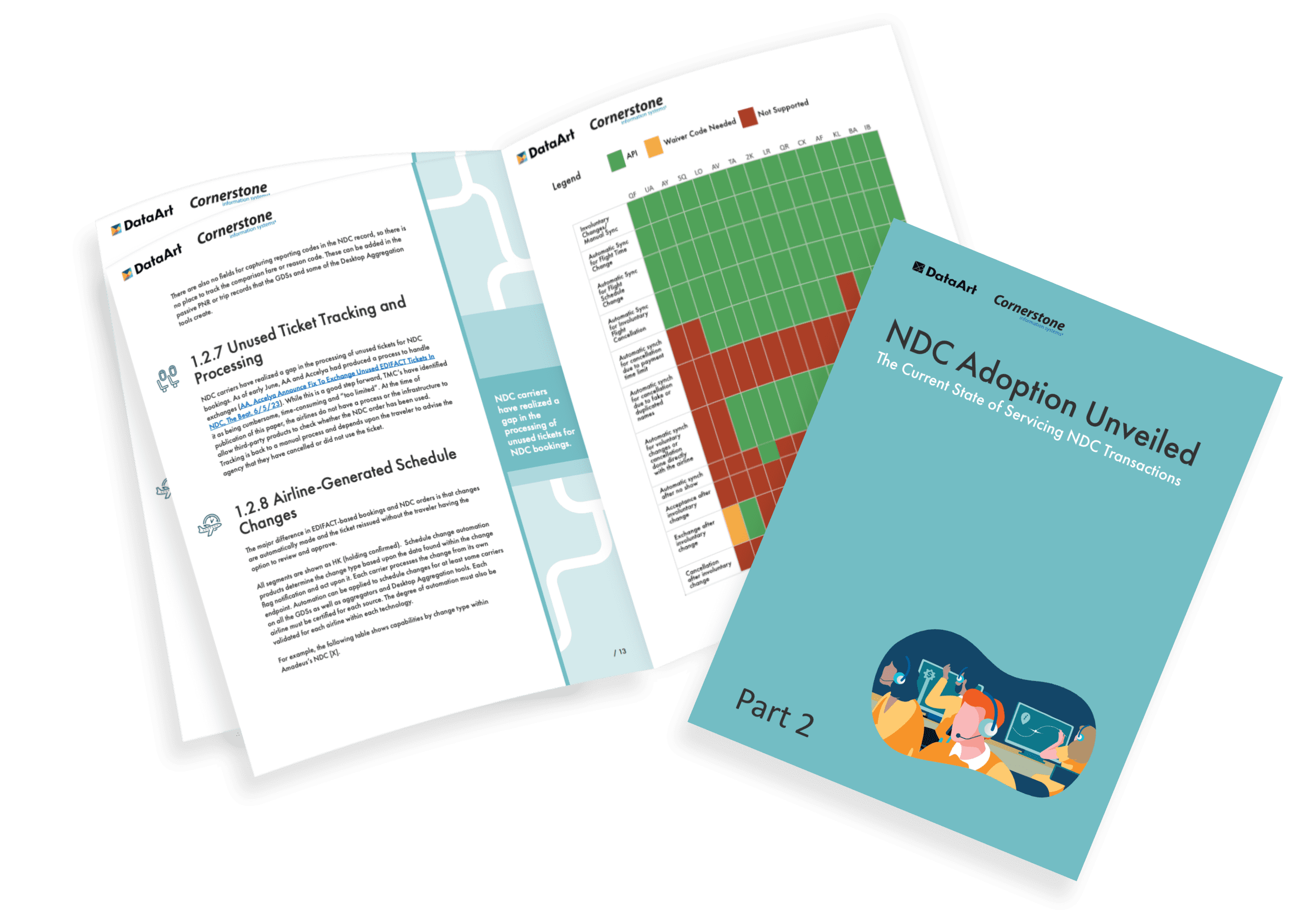A Practical Guide for Travel Distribution
Airline retailing is undergoing a transformation with the introduction of the New Distribution Capability (NDC). It is revolutionizing the way airlines distribute their services by enabling more personalized and differentiated offerings directly to the travelers they serve. NDC is designed to offer an airline’s travelers a more customized shopping and booking experience, with the ability to test different packaging and merchandising quickly and relatively inexpensively. As of today, more than 65 airlines are NDC certified. This represents more than half of IATA passenger volume.
NDC also has a major impact on almost every aspect of servicing the trip once the order is placed, from basics like issuing itineraries to more complex processes like unused ticket and schedule change management. Many of these issues are still being defined, leading to confusion and frustration.
Cornerstone has partnered with DataArt to provide an overview of NDC’s impact on servicing and a guide to navigating NDC adoption. Every operating environment is different, so the specifics will vary from operation to operation. Our observations represent a snapshot at this time,so we cannot guarantee the absolute accuracy of the information or how it will evolve. Please think of our NDC guidance as a useful foundation to springboard your planning.
At the end of the blog, you can download two-part set of white papers with more details and specifics including:
- Known challenges and limitations
- Specific scenarios and recommendations for NDC adoption
- How NDC records differ from the traditional EDIFACT-based PNRs
- The operational capabilities required to service NDC bookings through various channels.
Overview of NDC
New Distribution Capability (NDC) represents a transformative technological standard within the airline industry that aims to revolutionize the way air travel products are distributed and sold. NDC aims to break away from the limitations of the traditional Global Distribution System (GDS) model, allowing airlines to present their offerings in a more dynamic and flexible manner.
The NDC framework facilitates the creation of tailored bundles, ancillary services, and fare options, empowering airlines to better address individual traveler preferences and enhance the shopping and booking experience. It also opens up opportunities for airlines to foster direct relationships with their customers, optimize revenue management, and offer differentiated products and services across multiple channels, such as real time seat upgrades and dynamic pricing.
Many of the airlines we have spoken with are focused on personalization and merchandising. They value speed and the ability to test, learn and adapt. Their focus is also primarily on offers within their own airline, not across the entire market. Distributors, especially Travel Management Companies (TMCs), are focused on providing choice across the entire marketplace and on service delivery that can span multiple airlines, rail, hotel, and ground transportation providers in a single trip. They are often responsible for managing corporate travel policy fairly and consistently. Legacy distribution and mid-office systems lack the structure and flexibility to support NDC transactions. Online Travel Agencies (OTAs) and Online Booking Tools OBTs) don’t face all the same complexities. Some have implemented NDC at scale, but still face many of the servicing challenges. Our goal is to help bridge the gap by focusing on values and objectives that everyone has in common: a great customer experience delivered in the most efficient, cost-effective way possible.
NDC has the potential to transform the way air bookings are sold and serviced and could become a win for everyone in the value chain, from travelers to corporate travel buyers, travel distributors, airlines and the many companies that support them. However, as the issues around economics, customer data and power-balance evolve, the ability to service NDC bookings is critical. And there is a lot of work ahead to get things running smoothly. Understanding where servicing stands today, within a practical set of distribution models, is a great place to start. We hope our information and insights make a small contribution to that understanding. We also hope to trigger constructive dialogue across the distribution and servicing spectrum to validate and update this information, and then to move on to the fun part – resolving the issues together and providing great travel experiences – profitably – for all.
To equip our distribution and technology partners with practical, actionable information about NDC, the DataArt Travel R & D team and Cornerstone’s travel experts analyzed NDC adoption processes and defined NDC’s record structure and its implications on post-ticketing operations. We created two white papers to share our insights and recommendations for your NDC journey. Part 1 provides an overview of NDC, the resulting emergence of hybrid EDIFACT and NDC distribution models, and indicative solution architectures for servicing bookings in the new models. Part 2 focuses on how NDC records differ from the traditional EDIFACT-based PNR, and the operational capabilities required to service NDC bookings through various channels.
Want to learn more about the NDC Adoption? Check out the white papers here: NDC Adoption Unveiled – Cornerstone Information Systems.
